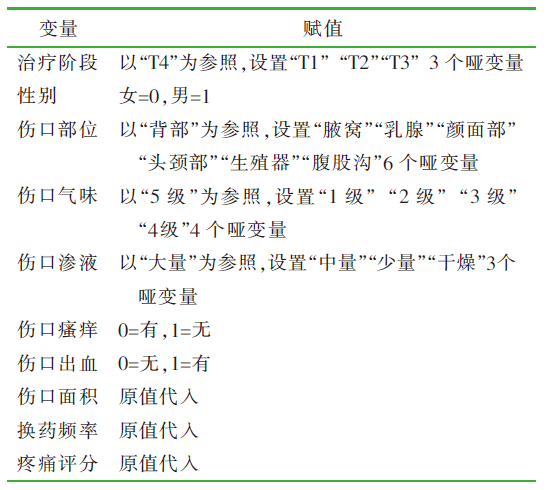| [1] |
Grocott P, Gethin G, Probst S. Malignant wound management in advanced illness:new insights[J]. Curr Opin Support Palliat Care, 2013, 7(1):101-105.
doi: 10.1097/SPC.0b013e32835c0482
|
| [2] |
American Cancer Society. Cancer Facts and Figures[EB/OL].(2017-12-22).https://www.cancer.org/research/cancer-facts-statis-tics/all-cancer-facts-figures/cancer-facts-figures-2017.html .
|
| [3] |
Tilley CP, Fu MR, Qiu JM,et al. The microbiome and meta-bolome of malignant fungating wounds[J]. J Wound Ostomy Cont Nurs, 2021, 48(2):124-135.
|
| [4] |
Tandler S, Stephen-Haynes J. Fungating wounds:management and treatment options[J]. Br J Nurs, 2017, 26(12 Suppl):S6-S14.
|
| [5] |
Tilley C, Lipson J, Ramos M. Palliative wound care for malignant fungating wounds:holistic considerations at end-of-life[J]. Nurs Clin North Am, 2016, 51(3):513-531.
doi: 10.1016/j.cnur.2016.05.006
|
| [6] |
Monfre JM, Kelechi TJ, Magwood GS,et al. Development and psychometric evaluation of the symptom intrusiveness rating scale among individuals experiencing pain associated with chronic wounds[J]. J Wound Ostomy Continence Nurs, 2015, 42(5):474-479.
doi: 10.1097/WON.0000000000000160
|
| [7] |
李孟喜, 柏素萍, 魏青. 中文版症状生活干扰评估量表在慢性伤口疼痛患者中的信效度检验[J]. 中国实用护理杂志, 2018, 34(31):2414-2417.
|
|
Li MX, Bai SP, Wei Q. Reliability and validity of Chinese version of Symptom Intrusiveness Rating Scale among patients experiencing pain associated with chronic wound[J]. Chin J Pract Nurs, 2018, 34(31):2414-2417.
|
| [8] |
Naylor W. Symptom control in the management of fungating wounds[EB/OL].[2020-11-02]. http://www.worldwidewounds.com/2002/march/Naylor/Symptom-Control-Fungating-Wounds.html .
|
| [9] |
Carlsson AM. Assessment of chronic pain. I. Aspects of the reliability and validity of the visual analogue scale[J]. Pain, 1983, 16(1):87-101.
doi: 10.1016/0304-3959(83)90088-X
pmid: 6602967
|
| [10] |
Lo SF, Hu WY, Hayter M,et al. Experiences of living with a malignant fungating wound:a qualitative study[J]. J Clin Nurs, 2008, 17(20):2699-2708.
doi: 10.1111/j.1365-2702.2008.02482.x
|
| [11] |
Gramling R, Ingersoll LT, Anderson W,et al. End-of-life pref-erences,length-of-life conversations,and hospice enrollment in palliative care:a direct observation cohort study among people with advanced cancer[J]. J Palliat Med, 2019, 22(2):152-156.
doi: 10.1089/jpm.2018.0476
pmid: 30526222
|
| [12] |
Cornish L. Holistic management of malignant wounds in palliative patients[J]. Br J Community Nurs, 2019, 24(9):S19-S23.
|
| [13] |
Probst S,Arber A,Faithfull S.Probst S,Arber A,Faithfull S. Malignant fungating wounds:the meaning of living in an unbounded body[J]. Eur J Oncol Nurs,2013, 17(1):38-45.
doi: 10.1016/j.ejon.2012.02.001
|
| [14] |
Winardi A, Irwan AM. Topical treatment for controlling malignant wound odour[J]. Journal EWMA (JEWMA), 2019, 20 (2):7-13.
doi: 10.35279/jewma201910.01
|
| [15] |
European Oncology Nursing Society(EONS). Recommendations for the care of patients with malignant fungating wounds(2015)[EB/OL].[2019-11-18]. https://www.cancernurse.eu/do-cuments/EONS Malignant Fungating Wounds.pdf
|
| [16] |
周帅, 江锦芳, 覃彦珠,等. 恶性肿瘤伤口症状管理的最佳证据总结[J]. 护理学杂志, 2020, 35(20):92-97.
|
|
Zhou S, Jiang JF, Qin YZ,et al. Summary of best evidence regarding symptoms management of malignant fungating wounds[J]. J Nurs Sci, 2020, 35(20):92-97.
|




